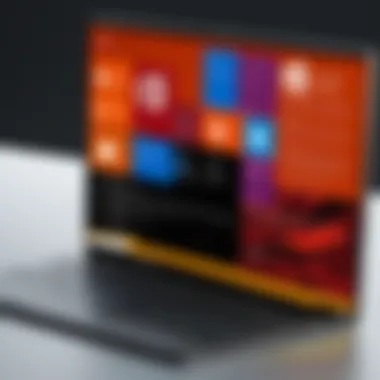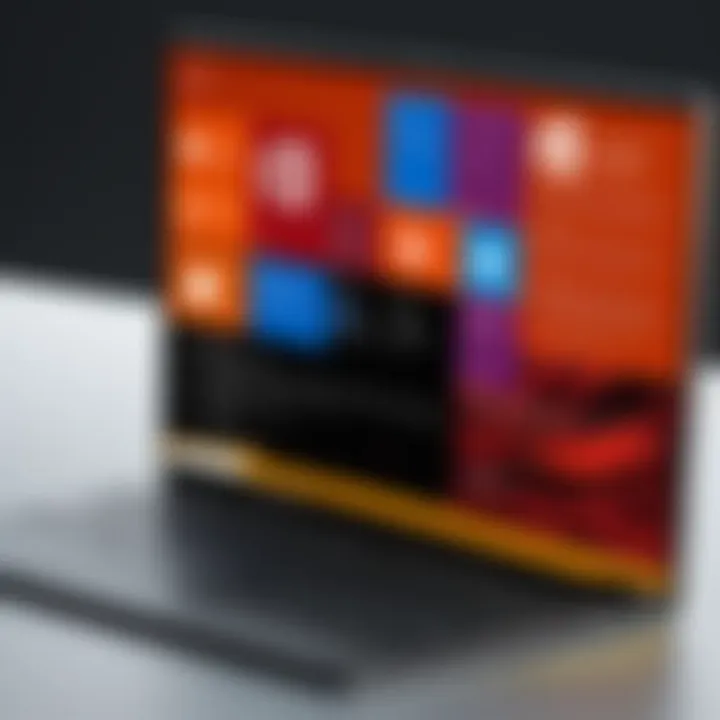Guide to Buying a Genuine Windows 10 Product Key


Intro
Purchasing a product key for Windows 10 is no small feat, especially in this digital age where the landscape is littered with both legitimate sellers and a myriad of dubious vendors. As more people rely on technology for both personal and professional tasks, understanding how to navigate this market becomes crucial. Whether you are a tech enthusiast eager to unlock the full potential of your system, a gamer looking to ensure seamless gameplay, or an IT professional tasked with managing software installations, you need to tread carefully.
The process may seem daunting, yet it doesn’t have to be. This guide will provide you with a roadmap, detailing everything from choosing the correct product key, identifying trustworthy sellers, to avoiding the pitfalls associated with counterfeit software. With this knowledge in hand, you'll be equipped to make an informed decision that won't leave you in a bind later on.
Product Overview
Acquiring a genuine Windows 10 product key involves more than just a simple transaction. Understanding the landscape of available keys and vendors will help you avoid common traps.
Brand Information
Windows 10 is developed by Microsoft, a tech giant known for its innovation and robust software products. Their reputation is built on reliability and user experience, which is why many users opt for their operating systems.
Key Specifications
Depending on your needs, there are different types of Windows 10 product keys:
- Retail Keys: These can be used on multiple devices, as long as one copies the license from the previous device.
- OEM Keys: Typically tied to a new machine, they usually come pre-installed on hardware. They're cheaper but less flexible.
- Volume Licenses: These are meant for organizations that need to activate multiple copies simultaneously.
Pricing
The price for a product key can vary widely based on its type:
- Retail keys generally range from $139 to $199.
- OEM keys can be found anywhere between $50 to $130.
- Volume licenses can vary significantly depending on the size of the organization and specific agreements with Microsoft.
Risks of Unauthorized Sellers
Avoiding unauthorized sellers should be a top priority. Purchasing from them can lead to long-term headaches, including activation issues and compromised system security.
While it may be tempting to look for the cheapest deal online, some sellers offer keys that are already used, locked, or outright counterfeit.
Why You Should Be Careful
- Counterfeit Software: You risk installing software that could be riddled with malware.
- Non-Functional Keys: There's a chance you might get a key that doesn’t activate, which is like throwing money out the window.
- Legal Repercussions: Using pirated software can lead to hefty fines or worse.
Recommendations for Legitimate Sources
To steer clear of these risks, it’s wise to stick to reputable sources when purchasing your product key. Some of these include:
- Microsoft Store: The safest bet, providing the assurance that you’re getting a legitimate product.
- Authorized Retailers: Check for physical stores or online outlets that have a track record of selling Microsoft products reliably.
Repercussions of Using Counterfeit Keys
Adopting a counterfeit key may not just lead to inconvenient prompts for activation. Other consequences include:
- Frequent reboots due to software instability.
- Loss of access to official updates and features.
- Potential data loss—breach of trust with your own files.
Culmination
Understanding the intricacies involved in purchasing a Windows 10 product key can save you time, money, and a great deal of frustration. With this guide, you should feel better prepared to enter the marketplace, making choices that not only fulfill your immediate needs but also contribute to your long-term digital health. Remember to always vet your sellers and opt for official channels.
By following these guidelines, you can not only protect your investment but also ensure you have a stable and secure operating experience.
Preamble to Windows Product Keys
In the ever-evolving world of technology, the significance of product keys, particularly for Windows 10, cannot be overstated. These little alphanumeric sequences serve as a gateway, granting users access to the robust functionality of one of the most popular operating systems globally. But, why should one bother learning about these keys? For tech enthusiasts, gamers, and IT professionals alike, understanding Windows 10 product keys is crucial, not just for compliance, but for optimizing their computing experience.
A product key is fundamentally a unique identifier that activates the Windows 10 operating system on your device. Getting this right ensures that you benefit from regular updates, support from Microsoft, and most importantly, security fixes. Failing to utilize an authentic product key can leave users vulnerable to malware and other cyber threats.
Understanding Product Keys
When diving deeper into the core of product keys, it’s essential to grasp what they really are. Generally speaking, a Windows 10 product key consists of 25 characters, formatted in five groups of five. An example may look like this:
These keys are not just a string of random letters and numbers; each one is linked to a specific license agreement with Microsoft. This connection means that your product key not only authenticates your copy of Windows but also ties it to your Microsoft account, providing a seamless experience across devices.
Having this key in your pocket is like holding a ticket to enter an exclusive club. Without it, you’re left standing outside, looking in—unable to enjoy the full spectrum of features Windows 10 offers.
Purpose of Product Keys
The purpose of a product key stretches beyond mere activation of the operating system. Here are a few key functions:
- Validation: The primary role of a product key is to verify that your Windows 10 copy is genuine. It helps avoid the pitfalls of piracy, ensuring that only licensed users have access to Microsoft's premium support and updates.
- Personalization: Upon activation, users can tailor various settings that improve their interaction with the system. A valid key not only allows for customization but ensures that these preferences are securely stored in Microsoft’s cloud.
- Support and Updates: By using a legitimate product key, users can access essential updates that enhance system security and introduce new features. This not only keeps your device running efficiently but also significantly reduces risks posed by outdated software.
"A legitimate product key not only protects your device but also opens doors to a wider world of support, security, and software enhancements."
Understanding these elements not only positions the reader to make informed choices when purchasing a Windows 10 product key, but also highlights the overarching importance of authenticity and personal accountability in the world of software licensing.
Types of Windows Product Keys


Understanding the various types of Windows 10 product keys is crucial for anyone looking to purchase one. Each type comes with its own unique features, benefits, and limitations, catering to different needs and scenarios. It sets the stage for making an informed decision tailored to personal or organizational requirements. Knowing the ins and outs of these keys can save users a lot of time, money, and frustration down the line.
Retail vs. OEM Keys
Retail Keys are generally available for individual consumers. They can be bought directly from the Microsoft Store or authorized retailers. These keys provide flexibility; they can be transferred to a new device if the original computer is retired. This can be particularly valuable for tech enthusiasts who often like to upgrade their systems. Moreover, retail keys typically come with robust customer support from Microsoft, ensuring assistance when needed.
OEM (Original Equipment Manufacturer) Keys, on the other hand, are tied to a specific machine. You will find these keys pre-installed on computers that come with Windows 10 out of the box. Because of this, they cannot be moved to another device once registered. While they often come at a lower price point compared to retail keys, the trade-off is significant—they usually lack the same level of support. Technically savvy users must weigh whether the savings justify the limits on transferring the key.
Here’s a quick comparison:
- Retail Keys
- OEM Keys
- Flexible, transferable
- Higher cost
- Full support from Microsoft
- Non-transferable
- Lower price
- Limited support
Understanding these differences can prevent unpleasant surprises in the future.
Volume Licensing Keys
For businesses, Volume Licensing Keys serve as an economical solution for purchasing Windows 10. This option targets companies, educational institutions, or large organizations needing multiple licenses. With volume licensing, organizations can save a significant amount on software costs by acquiring a single key that covers multiple installations. Each key can license numerous devices, depending on the agreement, which adds convenience to large-scale deployments.
Furthermore, volume licenses may offer benefits like flexible activation methods, making it easier for IT departments to manage software across various machines. Therefore, if you're in charge of IT in an organization or are part of a large enterprise, considering this route might save both cost and time in the long haul.
Digital Entitlement
Digital entitlement, now commonly referred to as digital licenses, is an interesting option introduced with Windows 10. This feature allows users to activate Windows without needing to input a product key, as long as the digital license is linked to their Microsoft account.
For those who upgraded from a genuine copy of Windows 7 or 8.1, digital entitlement automatically activates Windows 10 without additional purchases. This is beneficial for users who want hassle-free installation on compatible hardware; all they need is Internet access, and their device can be recognized by Microsoft. However, users need to be cautious; if they change their hardware significantly, like replacing the motherboard, they might need to reactivate Windows, potentially requiring a product key.
In summary, understanding these key types makes it easier to choose the right path when purchasing a product key for Windows 10. Each option provides different advantages depending on the user’s objectives, so weighing the options based on your specific needs is essential.
"Choosing the right Windows 10 product key can have a big impact on your computing experience in the long run. It's best to do your homework before making a purchase."
Legitimate Sources for Purchasing Keys
Finding the right source for purchasing a product key for Windows 10 is crucial. Not only does it impact the legitimacy of your key, but it also affects your overall experience with the operating system. Choosing reputable sources ensures that you get a valid product key, along with the additional benefits that come from buying directly from Microsoft or authorized resellers. Here are some legitimate options worth considering:
Microsoft Store Direct Purchase
When it comes to buying a product key, the Microsoft Store is the gold standard. Buying directly from the source gives you peace of mind, knowing that your key is not only genuine but also properly integrated with Microsoft's ecosystem.
Here’s what makes this option stand out:
- Authenticity Guaranteed: You can be confident that the key is 100% valid.
- Straightforward Process: The online shopping experience is user-friendly, minimizing fuss and complications.
- Access to Updates: Direct purchases often include easy access to system updates and enhancements.
Additionally, buying from the Microsoft Store might grant you benefits like promotions or offers that third-party sellers don’t provide. It's wise to keep an eye on seasonal sales or special deals that can lead to significant savings!
Authorized Resellers
Not everyone may prefer to shop directly at the Microsoft Store, and that's where authorized resellers come into play. These are retailers or online vendors given official permission to sell Microsoft products, including Windows 10 product keys. Here are some notable advantages:
- Wider Availability: You may find local retailers that offer competitive pricing.
- Variety of Offers: Some resellers provide bundles or discounts that can lower your total cost.
- Customer Support: Established resellers typically offer customer support services that can help if you encounter issues.
However, caution is required here. Ensure you are purchasing from reputable names, like Amazon, Newegg, or local electronics stores known for authenticity. Check customer reviews and their return policy before proceeding.
Academic Discounts and Programs
For students and educational institutions, academic discounts present a unique opportunity to acquire Windows 10 product keys at a reduced price. Many universities and colleges partner with Microsoft to offer these keys to students and staff. Key points include:
- Significant Savings: Educational pricing can be substantially lower, making it easier on the wallet.
- Licensing for Multiple Users: Often, institutions provide licenses for entire labs or classrooms, promoting a learning-friendly environment.
- Immediate Access: Once you're verified as a student or staff member, the process is usually quick and seamless.
Finding these discounts can sometimes be like searching for a needle in a haystack, but checking with your school’s IT department or website is a good start. Many universities provide links that guide you through the process of obtaining your student key.
Tip: Always have your school email or student ID handy when applying for these discounts!
Legitimate sources for purchasing Windows 10 product keys ultimately offer security, reliability, and potentially significant savings. By exploring these options, you can make an informed decision that serves you well in the long run.
Risks of Purchasing from Unauthorized Sellers
Buying a product key for Windows 10 isn’t always a walk in the park, especially when it comes to sifting through the many offers floating around on the internet. Unfamiliar sellers often promise the moon for a fraction of the price you’d pay at legitimate stores. However, navigating this landscape carries some serious risks that can cause headaches down the line. Understanding these risks can equip you to make better decisions.
Legal Implications
One of the biggest concerns with unauthorized sellers is the potential legal ramifications. Purchasing a product key from an unofficial source could land you in hot water. This happens because these keys are often obtained through questionable means, like hacks or stolen accounts. The end result? You may be violating Microsoft’s terms of service without even realizing it. If caught, users can face legal action from Microsoft, which may include hefty fines or, worst case, being banned from using the software altogether.
Furthermore, in some jurisdictions, buying counterfeit or pirated products is illegal and could lead to criminal charges. Always remember, a deal that sounds too good to be true probably is.
Potential for Scams
Scams are rampant in the world of cyberspace, and the arena of Windows 10 product keys is no exception. Many unauthorized sellers present themselves as legitimate, boasting user reviews and attractive offers to entice unwitting buyers. But what happens when you send your hard-earned cash their way?
Most often, people find themselves in one of two scenarios: either they’ve forked over the cash only to receive a key that doesn’t activate, or they get nothing at all. Cases of identity theft also crop up when buyers provide personal information, thinking they are making a legitimate purchase.


"If something seems fishy, it probably is. Trust your gut and steer clear of suspicious offers."
Impact on System Functionality
Aside from legal and financial issues, buying keys from unauthorized sellers can seriously affect your system functionality. Genuine product keys from Microsoft ensure that the software works as intended, providing updates, support, and security patches. Conversely, keys obtained from unauthorized sources may not activate properly or could deactivate your Windows installation after a while. Imagine the frustration of finding out that a key you bought for cheap is rendered useless just when you need it most.
All in all, these risks underscore the importance of purchasing Windows 10 keys from reliable sources. Understanding these potential pitfalls is key to protecting your investment and maintaining the integrity of your operating system.
How to Identify Genuine Product Keys
When it comes to sourcing a product key for Windows 10, the importance of recognizing a genuine key can’t be overstated. The digital marketplace is rife with options, but not all pathways lead to legitimate purchases. Understanding how to pinpoint authentic keys is a skill that can save you from a world of trouble—be it through wasted money or deactivated systems. A legitimate key guarantees that not only are you complying with Microsoft’s licensing agreements, but also that you are investing in software that is safe and functional.
Examining Product Key Formats
One way to authenticate a Windows 10 product key is by examining its format. Typically, a legitimate product key consists of a sequence of 25 characters broken into five groups of five characters each. For example:
Here’s a few elements to keep in mind:
- Genuineness: Genuine keys will follow this format without exceptions. If the key you have doesn’t align with this structure, it’s a red flag.
- Regional Variations: While the format remains consistent, certain product keys may contain country-specific identifiers. It is worthwhile to check against Microsoft’s official resources to confirm.
- Pricing Anomalies: If a key is being offered at a price that seems too good to be true, it probably is. Pricing that deviates significantly from Microsoft’s standard should raise your eyebrows.
Overall, if the format’s not up to par or there are discrepancies in its structure, it’s best to steer clear and opt for a more reliable source.
Checking Activation Status
Once you acquire a product key, it’s crucial to ensure its activation status. Windows 10 allows you to check the activation status easily, giving you a snapshot of whether the installed copy is genuine or if it comes with issues.
To check the activation status, follow these steps:
- Click on the Start Menu and navigate to Settings (the gear icon).
- Go to Update & Security and select Activation from the sidebar.
- Look for the activation status – it should read “Windows is activated” followed by a product key.
If you see any warnings or errors, it’s a signal that your key might not be legitimate. Being proactive by running this check can save you from future headaches.
In summary, being able to identify genuine product keys is an essential part of successfully acquiring a genuine Windows 10 experience. By examining key formats and checking activation status, you take important steps toward ensuring you’re protected from fraud and other risks.
Price Considerations
Understanding the cost-related factors when purchasing a product key for Windows 10 is essential. Price can significantly influence your purchasing decision, but it shouldn't be the only factor you ponder. Balancing affordability with the assurance of authenticity is crucial for ensuring a long-lasting investment in your operating system.
When discussing price considerations, there are specific elements that deserve your attention:
- Market Demand: This fluctuates due to various factors such as promotions, holidays, or the introduction of new versions of Windows. Keeping your eyes peeled on these changes can help you snag a deal.
- Cost Comparison: Before settling on a key, compare multiple sources. Prices can vary widely between official Microsoft channels, authorized resellers, and even online marketplaces.
- Lifetime Value: Sometimes, splurging a bit more on a legitimate key can save you headaches later on. Cheaper, unofficial options may appear to be a better deal, but they could lead to activation issues or worse, scams.
In summary, price considerations go beyond just the number on the tag. Always weigh your options carefully while considering the potential risks and benefits.
Market Prices for Keys
In the realm of product keys, awareness of market prices is vital to avoid pitfalls. Generally, Windows 10 product keys can range from around $100 to $145 for retail versions. However, factors like the key type—be it OEM or volume licensing—can alter this range.
You may see lower prices on various platforms, but it’s essential to ask yourself:
- What’s the seller’s reputation?
- Is the key being offered with a warranty or support?
- Are there customer reviews to provide insight?
Don't be shy about shopping around. The difference between an overpriced key and a good deal might simply be a click away.
Evaluating Discounts and Offers
When navigating the world of discounts and offers, it’s important to tread carefully. Discounts can lead to excellent savings, but they can also lure in unsuspecting buyers. Keep your sense keen and know what’s reasonable. For example, a steep discount may look inviting, but if it’s too good to be true, it usually is.
Here’s a checklist for evaluating discounts:
- Check Authenticity: Look for certified promotions from Microsoft or authorized resellers.
- Expiration Dates: Ensure that the offer is current and doesn’t have strings attached.
- Usage Limitations: Some discounts may come with limitations, like usage on certain devices or geographic restrictions.
In this digital marketplace, not all that glitters should catch your eye. Assess discounts and offers wisely, and you will not only secure a key but also safeguard your future investments.
Alternatives to Buying a Product Key
When considering a Windows 10 product key purchase, it’s important to explore alternatives—not just for savings, but for practical functionality. The technology landscape demonstrates that exclusive reliance on purchasing product keys isn't always necessary or cost-effective. Knowledge about alternatives can lead to effective usage of Windows 10 without the hefty price tag or potential pitfalls. Circumventing unnecessary expenses while ensuring you have a fully operational system is crucial for both casual users and tech aficionados.
Upgrading from Previous Versions
One major alternative is upgrading from previous versions of Windows. If you already own Windows 7 or Windows 8, Microsoft has provided a streamlined upgrade path to Windows 10, often at little to no cost. This option allows you to harness the familiar interface and enhanced features without delving into the market for a fresh product key. Here’s what to consider:
- Eligibility Check: Not every version of Windows 7 or 8 qualifies for upgrade but most licensed versions do. It’s wise to check your current OS version to confirm your eligibility.
- Procedure: The upgrade process is relatively straightforward. Microsoft has laid out methods you can follow. Simply go to the Settings app in Windows, navigate to the Update & Security, and check for upgrade options.
- End-User License Agreement: Upgrades typically align with the licensing agreements of previous versions, providing a seamless transition.
By upgrading, one can avoid the process of purchasing a product key entirely, thus saving both time and money.
Using Windows Without Activation
Another route is using Windows 10 without activation. While this method bears mention, it's essential to tread cautiously. When you install Windows 10 without entering a valid product key, you can still access the operating system's core functionalities. Benefits include:


- Immediate Access: You gain immediate access to Windows 10 features and updates. It’s especially beneficial for those who might be trialing the OS before making a financial commitment.
- Performance: The system operates adequately without activation; many users may not notice significant differences in performance during regular use.
- Limitations Noted: However, certain limitations come into play. You might see watermark prompts or be unable to personalize your settings, which could be a deal-breaker for some users.
"While utilizing Windows 10 without activation can work in a pinch, it’s not a long-term solution."
Caveats to Consider:
- Regular reminders prompting activation can become annoying.
- The lack of full access could hinder advanced features, making it less appealing for enthusiasts or professionals.
In summary, exploring alternatives to outright purchasing a product key invites potential savings and greater access. It’s not about circumventing processes but rather making informed decisions that cater to your individual needs. Products like Windows 10 don’t necessarily dictate the narrative; users can navigate the terrain with alternative pathways.
Step-by-Step Process for Purchasing a Key
When it comes to securing a product key for Windows 10, following a structured process can save you a lot of headaches down the road. This section aims to guide you through the various steps necessary for purchasing a valid product key and activating it. Each step is designed to ensure you select the best option for your needs while also mitigating potential risks.
Selecting the Right Product Key
The very first step involves determining which type of product key aligns with your situation. There are primarily three types you could consider: retail keys, OEM keys, and volume licensing keys. Each one has unique features, including how they’re activated and the flexibility they offer.
- Retail Keys: These can typically be transferred between devices. Ideal for users who might upgrade their hardware in the future.
- OEM Keys: Tied to the first machine they are activated on. If you plan to stick with one device, this could be a viable option, usually at a lower price point.
- Volume Licensing Keys: Best for organizations and businesses that require multiple activations.
When selecting, think about your current and future needs. Do you foresee needing to switch machines? Or, do you prefer a cheaper option with limited flexibility?
Completing the Purchase
After deciding which key suits you best, it’s time to make the purchase. Start by heading to recognized platforms like the Microsoft Store or authorized resellers. Here's a quick checklist for an optimized purchasing experience:
- Verify seller credibility: Always check reviews and ratings.
- Look for clear return policies: Ensure you can return the product if something goes awry.
- Secure payment methods: Utilize methods that offer buyer protection.
Once the right seller is identified, follow their purchasing process—this usually entails adding the product to a cart and checking out. Keep an eye out: any vendor offering keys substantially cheaper than the market rates should raise a red flag.
Activating Windows
After you’ve successfully completed your purchase, activating your Windows 10 is the next step. This process typically is quite straightforward, but should anything go sideways, being prepared can save you a ton of time and frustration.
- Open Settings on Windows 10.
- Navigate to Update & Security and click on Activation.
- Select Change product key and enter the key you acquired.
- Follow the prompts to complete activation.
It might be worthwhile to note that if your activation fails, double-check the product key—typos happen. Also, confirming that it's compatible with your version of Windows is essential.
"The only thing worse than being blind is having sight but no vision." – Helen Keller
In summary, go through the steps one at a time, ensuring each piece is set before moving on to the next. Taking the time to do it right can lead to a more stable and more enjoyable experience with Windows 10.
Dealing with Issues Post-Purchase
Once you've got your hands on a Windows 10 product key, the journey isn't necessarily over. Factors such as activation hurdles or unexpected issues can arise, which is why this segment is crucial. Being prepared to tackle these problems can save frustration and ensure your system runs smoothly. Here, we delve into some of the common challenges and how to resolve them.
Troubleshooting Activation Problems
Activation problems might crop up suddenly, leaving you scratching your head. Typically, this could stem from several issues. Maybe you’re inputting the key incorrectly, or perhaps the key was sold to multiple people. It might also be a case of your internet connection throwing a tantrum at the worst moment.
Before you start pulling your hair out, try a few simple steps:
- Double-check the entry: Product keys are precise, and even the smallest mistake can lead to a failure.
- Internet Connection: Ensure that your device is connected to the internet. Sometimes, all it takes is a stable connection to validate your key.
- Error Codes: Microsoft often provides error codes when something goes awry. Searching for these errors online can lead you to potential solutions tailored to the specific issue.
If all else fails, you might need to re-activate. To do so, navigate to Settings > Update & Security > Activation and look for an option to troubleshoot. It usually handles common problems like a champ.
Seeking Support from Microsoft
If troubleshooting doesn’t yield any results, it might be time to seek help from the experts at Microsoft. Their support team has a reputation for addressing these kinds of concerns effectively.
There are several avenues you can take to get in touch with them:
- Microsoft Support Website: This is your first stop. They have extensive resources, including activation issues, step-by-step guides, and troubleshooting tips.
- Live Chat: Engaging in a live chat can be handy. You'll connect with a support agent who can walk you through solutions specific to your issue.
- Forums and Community Pages: Sometimes, fellow users can provide answers where official support might fall short. Websites like Reddit often host discussions where others share their experiences and fixes.
Remember, when reaching out to customer support, having your order details handy can streamline the process. Every bit of information helps them help you faster.
If problems persist, consider the moral of the story: having a direct line to professionals can often save you a lot of hassle in the long run.
The End
Purchasing a product key for Windows 10 is not just a technical transaction; it's a significant step that influences your whole experience with the Windows operating system. Understanding the ins and outs of what a genuine product key entails can help you dodge many common pitfalls associated with counterfeit or unauthorized keys. As this article has outlined, there are various aspects that one must consider before hitting that ‘buy’ button—ranging from the different types of product keys, legitimate sources to acquire them, to the potential risks tied to unauthorized sellers.
Recap of Important Considerations
In this guide, we've delved into several key points:
- Types of Keys: Knowing the difference between retail, OEM, and volume licensing keys affects your purchase.
- Legitimate Sources: Always prioritize buying from Microsoft or authorized resellers to ensure the key's authenticity.
- Risks of Unauthorized Sellers: Recognize the legal implications and the potential for scams that could compromise your system.
- After Purchase Support: Familiarize yourself with troubleshooting methods and how to seek help from Microsoft if issues arise.
These considerations are crucial for ensuring you obtain a key that functions perfectly and aligns with your needs. Ignoring these details can lead to costly mistakes.
Final Thoughts on Key Purchases
Ultimately, buying a genuine product key is a fundamental task that lays the groundwork for a smooth and satisfactory usage of Windows 10. It’s easy to overlook the importance of securing a real key amid the allure of discounts and questionable sellers, but making an informed decision cannot be overstated. In this age of digital piracy and rampant scams, arming yourself with knowledge is your best defense.
As technology evolves, so do the methods used by unscrupulous vendors. Therefore, maintain a critical eye on offers that appear too good to be true, and tread carefully. With the insights gathered throughout this article, you should feel empowered in your quest to acquire a Windows 10 product key that meets your requirements and assures you of a legitimate experience.
"An informed buyer is an empowered buyer."
In the end, remember: it’s your operating system; don’t settle for anything less than what’s rightfully yours.







